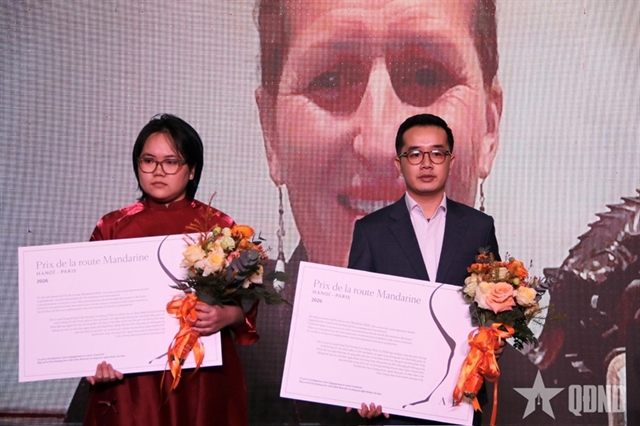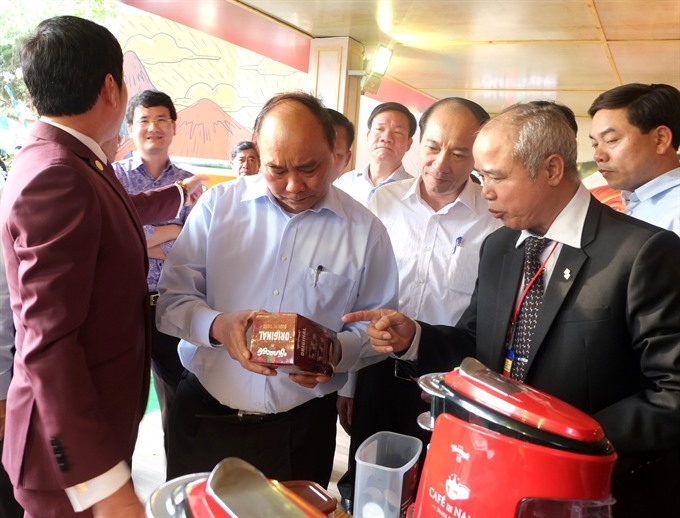 Economy
Economy

Prime Minister Nguyễn Xuân Phúc has urged the Central Highlands region to unleash its potential to attract investment, especially in the fields of high-tech agriculture, tourism, forestry and renewable energy.
 |
| Prime Minister Nguyễn Xuân Phúc (second from left) visits a coffee product booth at the international coffee fair in the Central Highlands province of Đắk Lắk on Saturday. — VNS Photo Bồ Xuân Hiệp |
Bồ Xuân Hiệp
ĐẮK LẮK — Prime Minister Nguyễn Xuân Phúc has urged the Central Highlands region to unleash its potential to attract investment, especially in the fields of high-tech agriculture, tourism, forestry and renewable energy.
The PM spoke at the fourth conference on investment promotion organised last Saturday in the Central Highlands province of Đắk Lắk.
He said the Central Highlands region plays a vital role in the country’s socio-economic development, and in national defence and security.
However, the region “has failed to tap its potential to attract investment”, Phúc said.
Although the country is one of the world’s leading coffee and pepper exporters, most of the products are unprocessed with low added value, he said.
The region needs to establish large-scale farming areas, pursue organic agriculture and expand the value chain of products from industrial trees, he said.
Localities in the region should also strengthen coordination with southeastern and central coastal regions to improve regional transport connectivity, he added.
On land and forest issues, the region needs to speed up forest planting and follow the Government’s directions on forest management and protection as well as sustainable forest recovery, he said.
“Protecting forests means protecting the environment, water resources, livelihoods of people and heritage space of our ancestors. Any activities of destroying forests and exploiting forest products illegally are a crime,” he said.
Phúc also urged the region to review the operation of hydropower plants in the region, particularly those that have a negative impact on the environment, forest and water resources.
In addition, the region was asked to develop qualified human resources and skilled management, and encourage technological innovation and transfer.
Regarding tourism potential, he said the region boasts a range of natural landscapes with climate suitable for tourism.
Phúc said the Government is determined to turn the Central Highlands epics into world intangible cultural heritage, and asked the region to conserve local cultural identities, especially the gong culture.
Minister of Public Security Tô Lâm, who is also head of the Central Highlands Steering Committee, said the committee would implement specific action plans in accordance with the Prime Minister’s direction.
Officials from the Central Highlands provinces signed agreements and delivered investment certificates for investors worth VNĐ80 trillion (US$3.5 billion), of which solar power projects accounted for $2 billion.
Commercial banks have committed to providing loans for the projects in the region worth VNĐ29 trillion ($1.27 billion).
Potential
The Central Highlands region covers an area of 5.46 million ha, accounting for 16.8 per cent of the nation’s total area. The region has a population of more than 5.6 million.
Of the 5.46 million ha of natural land, two million ha are used for agricultural production and 3.2 million ha are forestland.
The region has 74.25 per cent of the country’s red basalt soil at almost 2.1 million ha, making the region an ideal place to grow cash crops such as coffee, rubber and cashew nuts, among others.
Coffee is grown on 582,000ha, accounting for 90 per cent of coffee plantations nationwide, with an annual yield of about 1.37 million tonnes of beans, which is also over 90 per cent of the country’s total.
National productivity of robusta coffee is three times that of the world (2.5 tonnes against 0.8 tonnes a hectare).
The region grows more than 82 per cent of the nation’s pepper on 70,000ha.
Coffee, rubber and pepper are the agricultural mainstays of the region. Meanwhile, tea, particularly oolong tea, plays an important position in Lâm Đồng Province.
The GRDP (Gross Regional Domestic Product) in the 2011-15 period was about 10.45 per cent per annum.
In 2016, the GRDP per capita was VNĐ39.56 million ($1,700) – an increase of 8.57 per cent over the previous year.
In the 2011-15 period, the region attracted investments of VNĐ265.7 trillion ($11.7 billion) – double that of the previous five years. As a result, average annual growth rate in the period was 11.33 per cent.
To date, the region has 140 foreign direct investment (FDI) projects worth $772.5 million.
In 2016-20, the region is expected to attract more than VNĐ230 trillion ($10 billion) worth of investment.
The conference was attended by more than 500 leaders of the provinces of Gia Lai, Kon Tum, Đắk Lắk, Đắk Nông and Lâm Đồng, and representatives of commercial banks, local enterprises and investors.
The conference, organised by the Central Highlands Steering Committee, Ministry of Planning and Investment, and Đắk Lắk Province’s People’s Committee, is part of the sixth Buôn Ma Thuột Coffee Festival that ended today. — VNS




